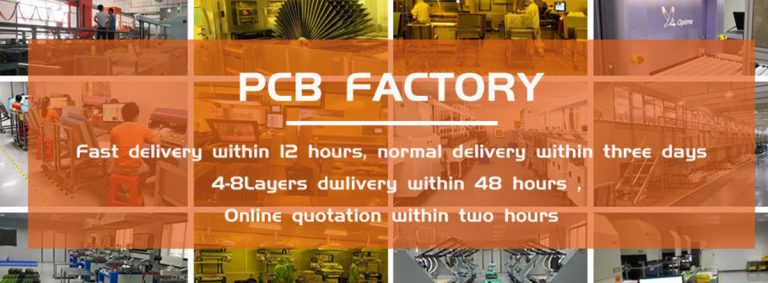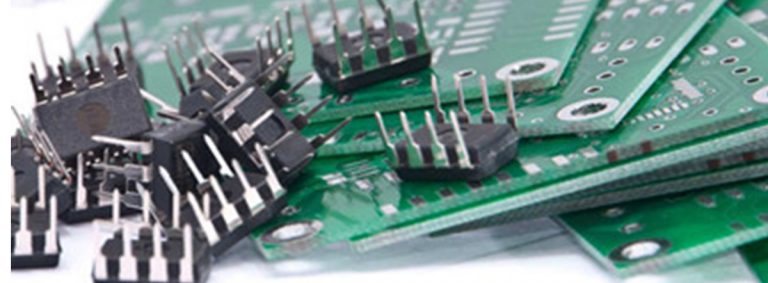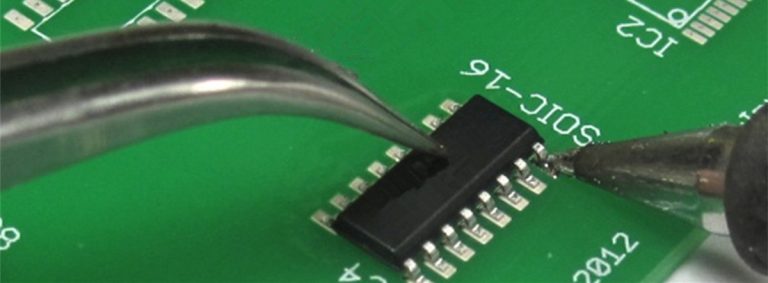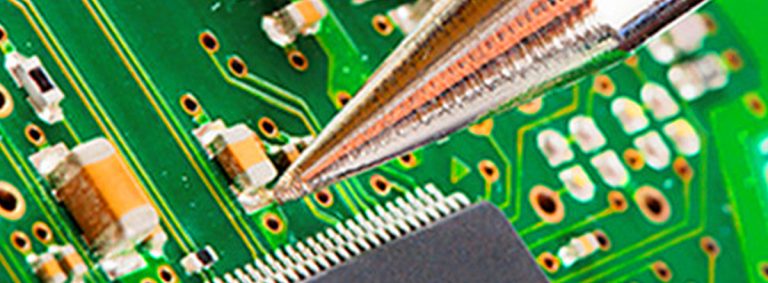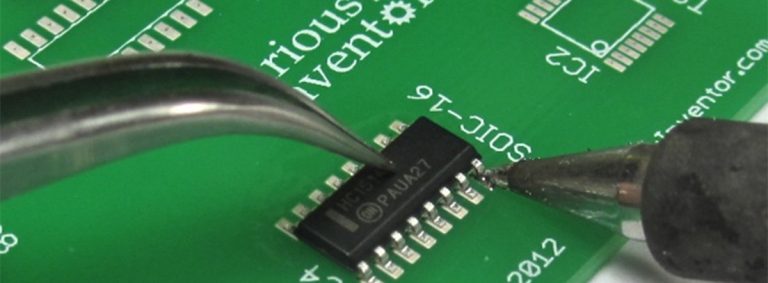Are Rigid-Flex PCBs the Key to Lighter, Smaller, and More Powerful Devices?
Ever dream of designing gadgets that twist and turn like a contortionist, but without the wires resembling a Medusa’s mane?
Introducing the game-changer in the electronics world: Rigid-Flex PCBs. Imagine circuit boards shedding their clunky armor and embracing the power of dance, effortlessly folding and unfolding to fit where rigid boards simply can’t go. No more battling tangled spaghetti in your headphones, no more feeling weighed down by brick-like devices – these hybrid heroes rewrite the rules of design.
Think of them as space ninjas, squeezing powerful functionality into the tiniest crevices. Weight watchers, rejoice! These featherweight boards shed pounds, crafting sleeker, lighter products. And for the reliability rockstars, bend without breaking is their anthem – built to last through countless contortions.
But their magic goes beyond mere flexibility. These masters of communication minimize crosstalk and electromagnetic interference, ensuring crystal-clear signals for your devices. They’re the wearable tech whisperers, conforming to the human body like a second skin, and the medical marvels, powering both implantable and external devices with enhanced adaptability.
Ready to unleash your inner roboticist? Rigid-Flex PCBs fuel dynamic movement and precise control for next-gen robots. And for the aerospace aces, they’re the high-performance solution for demanding environments, soaring above the competition.
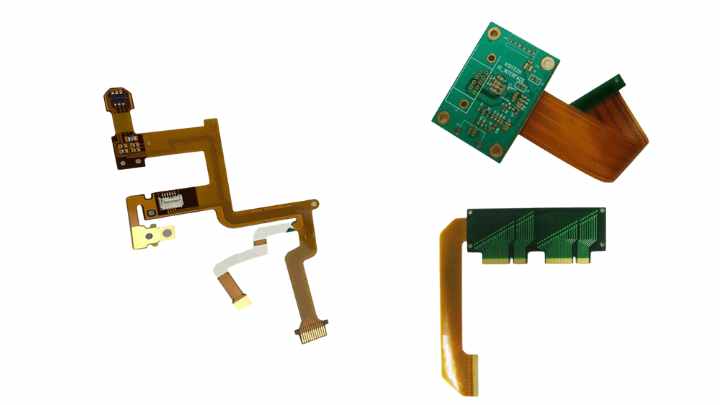
Demystifying the Hybrid: What are Rigid-Flex PCBs?
Picture a circuit board as a stoic mountain, unyielding and resolute, but suddenly equipped with the grace of a dancer, fluidly twisting and turning without compromising its strength. That’s the captivating charm of Rigid-Flex PCBs, hybrid heroes that rewrite the rules of design by merging the rugged reliability of traditional PCBs with the nimble flexibility of Flexible Printed Circuits (FPCBs). But before we marvel at their acrobatic feats, let’s peel back the layers and get to know their anatomy, fabrication, and the secrets to unleashing their full potential.
Anatomy of a Flexitarian: Rigid & Flexible Circuits Merging
- Rigid Layers: Imagine these as the bedrock of the board, just like traditional PCBs. Composed of sturdy PCB materials like FR4, they house critical components like chips and connectors, providing the essential backbone for the entire structure.
- Flexible Layers: Think of them as the nimble contortionists, crafted from thin, bendable films like polyimide or polyester. These flexible layers allow the board to twist and turn like a seasoned gymnast, accommodating tight spaces and dynamic movements without compromising electrical conductivity.
- Interconnects: These unsung heroes bridge the gap between the rigid and flexible worlds, ensuring seamless signal transmission regardless of the board’s contortions. From tiny vias that burrow through layers to conductive adhesives that bind seamlessly, these interconnects come in various forms, each with its own strengths and limitations.
Fabrication Techniques: Layering Up for Performance & Flexibility:
- Lamination: The heart of the process, where rigid and flexible layers are bonded together like a delicious mille-feuille, using heat and pressure to form a single, cohesive unit. This delicate alchemy of materials creates a robust yet adaptable platform for your circuitry.
- Patterning: Just like traditional PCB fabrication, copper traces are etched onto the layers, like intricate pathways guiding the flow of electricity. Laser ablation or mechanical milling techniques are often employed for flexible layers, ensuring precise patterning that withstands movement.
- Stiffeners and Reinforcements: Imagine placing strategically placed braces on a particularly bendy yogi – that’s the role of stiffeners and reinforcements in Rigid-Flex PCBs. These additional elements provide targeted support to critical areas, preventing unwanted flexing and ensuring the board maintains its structural integrity even during the most demanding contortions.
Design Considerations: Think in 3D for Optimal Bending & Functionality:
- Material Selection: Choosing the right blend of rigid and flexible materials is like selecting the perfect ingredients for a recipe. Polyimides offer superior heat resistance and flexibility for demanding applications, while FR4 provides a cost-effective option for less strenuous bends. Understanding the strengths and limitations of each material is key to unlocking the perfect flex for your design.
- Bend Radius and Fatigue: Every bend has its limit, even for the most agile contortionist. Understanding the bend radius of your chosen materials and factoring in fatigue life ensures the board performs flawlessly throughout its lifespan. Think of it like training your board for the marathon of its usage, ensuring it bends gracefully without succumbing to the wear and tear.
- 3D Design Tools: Ditch the flat sketches and embrace the future! Sophisticated 3D design software is your ally in understanding the nuances of your board’s movements. By simulating its bends and twists in a virtual environment, you can optimize its layout for optimal functionality and stress distribution. Think of it as building a virtual playground for your board, ensuring it performs flawlessly in the real world.
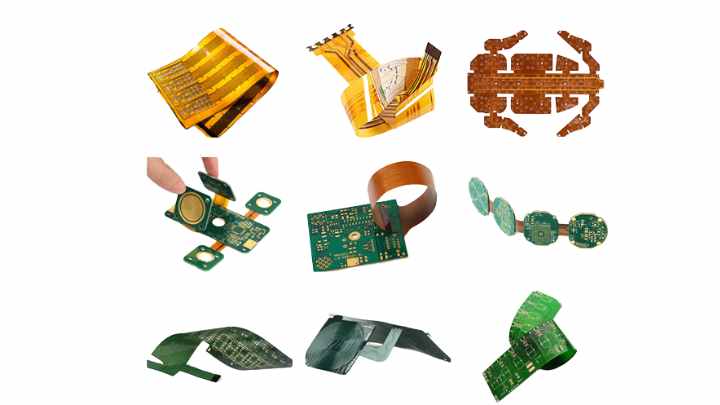
Bending the Rules: Unleashing the Advantages of Rigid-Flex PCBs
Imagine defying the tyranny of rigid electronics, where circuits twist and turn like seasoned contortionists, squeezing power into impossible spaces and shedding pounds like weight-watching champions. That’s the magic of flexible circuits, the game-changers rewriting the rules of design with their agile movements and unwavering performance. Let’s dive into their superpowers and see how they can revolutionize your next project.
Space Ninjas of Electronics:
- Conquering Cramped Quarters: Traditional circuits struggle with tight spaces, leaving precious real estate wasted. Flexible circuits, with their bendable ways, squeeze power into the tiniest nooks and crannies. Think wearable tech that hugs your body like a second skin, or medical devices that navigate intricate anatomies with ease.
- Maximizing Efficiency: Bulky connectors and wires become relics of the past with flexible circuits. They shrink your device footprint without sacrificing functionality, leading to sleeker, more compact products that are a delight to hold and use.
- Unlocking New Design Horizons: Forget the limitations of flat, rigid boards. Flexible circuits open doors to innovative shapes and configurations, allowing you to design devices that were previously unthinkable. Imagine curved displays, foldable phones, or even robots that morph and adapt to their environment – the possibilities are endless.
Weight Watchers of the Circuit World:
- Shedding Pounds, Gaining Performance: Every gram counts when it comes to portable devices. Flexible circuits replace heavy wires and connectors with their own lightweight construction, resulting in products that are significantly lighter and more comfortable to carry.
- Boosting Battery Life: Lighter devices consume less power, and that translates to longer battery life. Think of a phone that lasts through a weekend trip without needing a recharge, or a drone that soars for extended periods without weighing down its motors.
- Enhancing User Experience: Lighter electronics feel better in your hands and are easier to maneuver. Flexible circuits contribute to a more enjoyable user experience, making your devices a pleasure to use in any situation.
Reliability Rocks of the Circuit Jungle:
- Built to Bend, Not Break: Unlike their rigid counterparts, flexible circuits are designed for movement. They withstand millions of bends and contortions without compromising their electrical integrity. Imagine wearables that endure your most rigorous workouts, or medical implants that adapt to your body’s natural movements without malfunctioning.
- Reduced Wear and Tear: Traditional circuits can suffer from stress fractures and wire fatigue, leading to costly failures. Flexible circuits eliminate these weak points, minimizing wear and tear and extending the lifespan of your devices.
- Long-Term Stability: Invest in quality, and it pays off. Flexible circuits offer exceptional durability and resistance to harsh environments, ensuring your devices operate flawlessly for years to come.
Signal Senseis of the Circuit Spectrum:
- Crystal-Clear Signals: Flexible circuits minimize crosstalk, the interference that can distort signals between components. This ensures your devices operate at optimal efficiency and deliver reliable performance.
- Enhanced Electromagnetic Compatibility: Worried about interference with other devices or external signals? Flexible circuits boast superior EMI shielding, minimizing unwanted noise and ensuring flawless communication in even the most complex environments.
- Unleashing the Power of Precision: Clear signals are the foundation of accurate data processing and smooth operation. Flexible circuits pave the way for high-precision applications in areas like medical diagnostics, scientific instruments, and advanced robotics.
Where They Shine: Applications for Flexible Circuitry
Rigid-Flex PCBs, with their remarkable ability to bend and adapt, haven’t just pushed the boundaries of design – they’ve revolutionized entire industries. Now, let’s explore some dazzling examples of where these flexible heroes truly shine:
Wearable Tech Whisperer:
- Second Skin Sensation: Imagine fitness trackers hugging your curves, or smartwatches molding to your wrist like a loyal companion. Flexible circuits make this a reality, conforming to the human body with unparalleled comfort and functionality.
- Unleashing Design Freedom: Forget bulky straps and rigid casings – flexible circuits open doors to sleek, stylish wearables that feel like natural extensions of ourselves. Think ultra-thin earbud sensors or stylish headbands measuring brain activity.
- Enhanced Data Acquisition: With circuits bending and flexing alongside us, wearables gather richer data than ever before. Imagine monitoring movement with unprecedented accuracy, or capturing vital signs during dynamic activities with minimal interference.
Medical Marvel:
- Healing with Flexibility: From pacemakers that adapt to a beating heart to neural implants seamlessly integrating with the nervous system, flexible circuits are transforming medical technology.
- Minimizing Invasive Procedures: Smaller, more flexible devices reduce the need for bulky, invasive surgeries. Think drug delivery systems that navigate complex anatomies or prosthetic limbs that move with natural fluidity.
- Improving Patient Quality of Life: Flexible circuits make medical devices more comfortable and discreet, empowering patients to live fuller, more active lives. Imagine insulin pumps barely noticeable under clothing or cochlear implants discreetly blending into the head.
Robo Revolution:
- Dynamic Movement, Unmatched Control: The future of robotics isn’t limited to stiff, clunky machines. Flexible circuits enable robots to move with astonishing agility and precision, mimicking the grace of human and animal movement.
- Adapting to Unforeseen Terrain: Imagine robots traversing uneven surfaces, navigating tight spaces, and manipulating objects with delicate dexterity – all thanks to the adaptable nature of flexible circuits.
- Unleashing New Possibilities: From surgical robots performing intricate procedures to exoskeletons assisting human movement, flexible circuits are pushing the boundaries of what robots can achieve.
Aerospace Ace:
- Conquering Harsh Environments: From the scorching heat of satellites to the icy depths of space probes, flexible circuits endure extreme temperatures and vibrations, ensuring reliable performance in the most demanding conditions.
- Fueling Miniaturization: Flexible circuits allow for lightweight, compact electronics, crucial for space-constrained aerospace applications. Think compact control systems for drones or fuel-efficient avionics for spacecraft.
- Boosting Communication and Data Collection: With complex antennas and sensors seamlessly integrated into aircraft and spacecraft, flexible circuits optimize communication and data gathering, paving the way for safer, more efficient flights and space exploration.
Design & Manufacturing: Taming the Bend – Your Guide to Rigid-Flex PCBs
Taming the bend doesn’t just mean mastering yoga poses – it’s about crafting Rigid-Flex PCBs that move with grace and function flawlessly. But fear not, design enthusiasts! This section is your roadmap to navigating the intricacies of bringing your flexible circuit dreams to life. Let’s delve into the essential steps to ensure your bendable creations perform like champions.
Material Maestro: Choosing the Right Balance of Flexibility & Strength:
- Polyimides: Imagine the Iron Man suit’s adaptability – that’s polyimide. It offers superior heat resistance and exceptional flexibility, making it ideal for demanding applications like aerospace and medical devices.
- PET & PEN Films: Think of these as the budget-friendly options, offering good flexibility and affordability for less strenuous bends. They’re perfect for wearable tech and consumer electronics.
- FR4: Don’t underestimate the classic! FR4 provides a rigid backbone for your board, perfect for mounting components and ensuring structural stability. Think of it as the anchor in your flexible storm.
Software Savvy: 3D Visualization & Simulation for Flawless Designs:
- Ditch the Flat Sketches: Embrace 3D design software – your virtual playground for bending and twisting your board to its limits. Simulate real-world conditions, identify potential stress points, and optimize your design for perfect movement.
- Stress Analysis: Think of this as a virtual X-ray for your board. Software can predict how your design will handle stress and fatigue, allowing you to identify weak spots and reinforce them before any prototypes see the light of day.
- Manufacturing Compatibility: Don’t get blindsided by production hiccups. Choose software compatible with your chosen manufacturer’s processes, ensuring a smooth transition from design to reality.
Prototype Perfectionist: Ensuring Functionality Before Mass Production:
- One Stitch Saves Nine: Prototyping is your safety net. Before committing to mass production, build small-scale models to test your design’s functionality, flexibility, and durability. It’s cheaper to fix a bend in a prototype than an entire production run.
- Stress Testing: Put your prototype through its paces! Simulate real-world conditions like flexing, vibration, and temperature extremes to ensure your board can handle whatever it’s thrown at.
- Refine and Repeat: Prototyping is an iterative process. Don’t be afraid to modify your design based on test results. Each bend and tweak brings you closer to a flawless final product.
Partner Picker: Finding the Right Manufacturer – Expertise Matters:
- Experience is Key: Don’t entrust your bendable wonder to just anyone. Choose a manufacturer with a proven track record in Rigid-Flex PCB production. They’ll have the expertise and infrastructure to bring your design to life flawlessly.
- Communication is Critical: Clear communication is your bridge to success. Find a manufacturer who listens to your needs, understands your design, and keeps you updated throughout the production process.
- Quality Comes First: Don’t skimp on quality. Choose a manufacturer with rigorous quality control standards to ensure your Rigid-Flex PCBs perform reliably for years to come.
Cost Conscious: Demystifying the Numbers Behind Flexible Circuitry
Ah, the elephant in the room. Let’s talk money. Flexible circuits, with their bendy brilliance, might raise an eyebrow when it comes to cost. But before you write them off as budget-busters, let’s delve into the numbers and discover the value hidden within those flexible folds.
Factors Affecting Price: Complexity, Materials, & Volume – Unveiling the Formula:
- Complexity Counts: The intricacy of your design plays a role. Simple, single-layer boards with readily available materials will cost less than intricate multi-layer circuits with exotic materials. Remember, each bend, layer, and interconnect adds to the production complexity.
- PCB Material Matters: Polyimide, the king of flexibility, commands a premium compared to the workhorse polyester. However, its heat resistance and durability might translate to cost savings in the long run, especially for demanding applications.
- Volume Matters: As with any good deal, buying in bulk brings down the price per unit. If you’re planning mass production, the initial investment might be higher, but the cost per bendable circuit plummets, making it a wise long-term decision.
Rigid vs. Flex Face-Off: Understanding Long-Term Value & ROI:
- Upfront Cost: Traditionally rigid PCBs might seem like the budget-friendly option. But consider the hidden costs: bulky connectors, complex wiring, and potential redesign due to space constraints. Flexible circuits, while initially pricier, often simplify design, reduce component count, and save on assembly, potentially evening out the playing field in the long run.
- Weight Matters: Lighter devices translate to lower shipping costs, increased battery life, and happier customers. Flexible circuits shed pounds compared to their rigid counterparts, leading to potential cost savings and improved user experience.
- Innovation ROI: Think beyond the immediate price tag. Flexible circuits unlock new design possibilities, leading to innovative products that command premium prices and generate higher profits. Consider the bendable phone that revolutionizes the market – the initial investment can be recouped quickly through increased sales and brand recognition.
Investment in Innovation: Unlocking New Design Possibilities & Cost Savings:
- Reduced Assembly Time: Flexible circuits can eliminate complex wiring and intricate connectors, streamlining assembly processes and minimizing labor costs. Think of a wearable device that snaps together with pre-integrated circuits, saving precious production time and money.
- Minimized Defects: Fewer components and simpler designs mean fewer opportunities for errors. Flexible circuits, with their inherent durability and reduced wear and tear, can lead to lower defect rates and reduced warranty costs.
- Improved Reliability: Flexible circuits built to bend withstand real-world conditions better than their rigid counterparts. This translates to fewer product failures, returns, and customer service headaches, ultimately saving you money in the long run.
The Future is Flexible: Where Rigid-Flex PCBs are Heading
Rigid-Flex PCBs aren’t just bending the rules – they’re rewriting the entire design playbook. But the story doesn’t end here. The future of these bendable wonders is brighter than a million LEDs, promising advancements that will reshape entire industries and revolutionize user experiences. Buckle up, design enthusiasts, because the journey’s just getting started!
Material Magic: Advanced Materials & Miniaturization – Bending the Limits:
- Nano Wonders: Imagine circuits thinner than a human hair, woven from exotic materials like graphene and ultra-thin copper foils. These next-gen materials promise unprecedented flexibility, durability, and conductivity, paving the way for miniaturized devices previously unthinkable. Think implantable sensors smaller than a grain of rice or foldable smartphones thinner than a credit card.
- Self-Healing Circuits: Picture circuits that can repair themselves! Research into conductive polymers and biomimetic materials is exploring the possibility of self-healing circuits, extending device lifespans and minimizing maintenance costs. Imagine wearable tech that bounces back from accidental tears or medical implants that adapt to tissue growth without invasive surgery.
- Smarter Substrates: Envision substrates not just supporting circuits, but actively participating in their function. Research into integrated sensors and energy harvesting capabilities within the substrate itself is opening doors to intelligent devices that react to their environment and power themselves autonomously. Think smart clothing that monitors vital signs and charges from body heat or interactive displays that adjust brightness based on ambient light.
Unforeseen Horizons: New Applications & Industries Await:
- Beyond Wearables: While wearables have been the early adopters, flexible circuits are poised to conquer new frontiers. Think intelligent prosthetics that mimic natural movement, flexible displays integrated into furniture and walls, or even bendable solar panels that conform to curved surfaces. The possibilities are truly limitless.
- The Intelligent Home: Imagine walls embedded with flexible circuits that control lighting, temperature, and even entertainment systems. Flexible circuits can revolutionize home automation, creating dynamic, responsive environments that adapt to our needs and desires.
- The Evolving City: Picture bridges and buildings equipped with flexible sensors that monitor structural integrity and environmental conditions. Flexible circuits can enable predictive maintenance, improve safety, and optimize resource management in our urban landscapes.
A Flexible Future: Rigid-Flex PCBs Leading the Way in Innovation & Design:
The future of electronics is bendable, adaptable, and brimming with possibility. Rigid-Flex PCBs are more than just circuit boards – they’re the catalysts for a design revolution, empowering engineers and inventors to create products that were once confined to science fiction. As materials science advances and production techniques refine, the potential applications of these flexible heroes will continue to expand, shaping a future where technology seamlessly integrates into our lives, bends to our needs, and adapts to our ever-changing world. So, embrace the bend, let your imagination take flight, and join the movement towards a flexible future, one circuit at a time!
Rigid-Flex PCB FAQ
What are rigid-flex PCBs?
Rigid-flex PCBs are a hybrid construction of printed circuit boards, combining both rigid and flexible substrates. This allows the board to be bent or folded to fit the mechanical constraints of the device, offering a versatile solution for complex designs.
What are the disadvantages of rigid-flex PCB?
Despite their advantages, rigid-flex PCBs come with some drawbacks, including increased manufacturing complexity, higher cost, and potential challenges in repair and rework. Design changes can also be more challenging compared to traditional rigid or flexible PCBs.
What is the difference between FPC and rigid-flex?
Flexible Printed Circuits (FPC) are fully flexible PCBs, whereas rigid-flex PCBs combine both rigid and flexible portions in a single board. Rigid-flex offers more design flexibility in terms of shape and space utilization compared to FPC.
What is an example of a rigid PCB?
An example of a rigid PCB is the traditional FR4 board, which is a flat, inflexible substrate commonly used in many electronic devices. Rigid PCBs are suitable for applications where bending or flexibility is not required.
Are Rigid-Flex PCB reliable?
Rigid-flex PCBs can be highly reliable if designed and manufactured correctly. Proper attention to material selection, layer alignment, and fabrication processes is crucial for ensuring the reliability and durability of rigid-flex PCBs in various applications.
What are the benefits of rigid-flex PCB?
The benefits of rigid-flex PCBs include space savings, improved reliability due to fewer interconnects, enhanced design flexibility, and the ability to conform to non-planar surfaces. They are particularly advantageous in applications with size and weight constraints.
Where are rigid-flex PCB used?
Rigid-flex PCBs find applications in various industries, including aerospace, medical devices, automotive electronics, and consumer electronics. They are commonly used in devices where space constraints, weight reduction, and reliability are critical factors.
What are the two different types of rigid PCB?
The two main types of rigid PCBs are single-sided and double-sided. Single-sided boards have components on only one side, while double-sided boards have components on both sides. More complex designs may require multi-layer rigid PCBs.
What is the difference between flex PCB and FPC?
“Flex PCB” is a general term for flexible printed circuit boards, while “FPC” specifically refers to Flexible Printed Circuits. FPC is a subset of flex PCB, emphasizing fully flexible circuits that are often thin and lightweight.
Why is Flex PCB so expensive?
Flex PCBs can be more expensive due to the specialized materials and manufacturing processes involved. The flexible substrates, such as polyimide, and the precision required in manufacturing contribute to the overall cost.
Is Flex PCB expensive?
Yes, flex PCBs can be more expensive compared to rigid PCBs. The cost is influenced by factors such as material type, complexity of the design, and the manufacturing processes involved in creating flexible circuits.
How many layers can a flex PCB have?
The number of layers in a flex PCB depends on the specific requirements of the design. Flex PCBs can range from single-layer to multi-layer constructions, with the layer count determined by the complexity of the circuit and the desired functionality.


